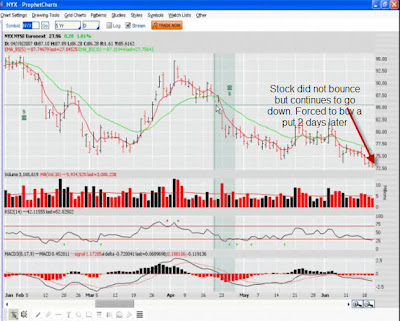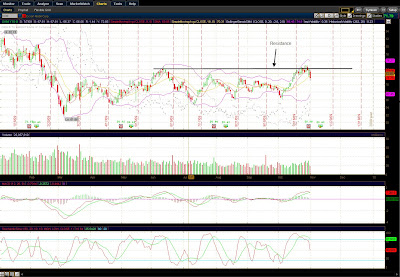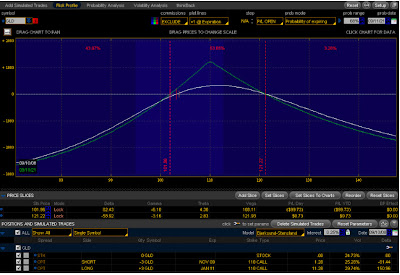This is an example of the discipline applied on how a real trade was turned from losing money to making profit.
To adjust the trade, the following guidelines were followed:
STAGNANT TREND: - adjust to Call Calendar or Bull Call Calendar
BEARISH Trend
- STOCK NEAR RESISTANCE : synthetic collar
- STOCK NEAR SUPPORT: -à bear call or Calendar Strangle
- STOCK DROPS >20% à Dollar cost average or buy more calls
The following trade followed the above guidelines:
1. NYX Long Call - April 02 buying Jan 09 95 LC( 20 months ) for $22.5

- Trend is bullish
- Trade placed in April 2 for Jan 09 – 20 months for trade to work
2. April 13 - Trend is stagnant

Stagnant - adjust to Call Calendar
- April 13 – Long call -à Call Calendar
- Sell April 95 ( 1 week left before expiration ) for 1.75 and at RESISTANCE
- Note that stock had dropped, MACD had turned but it is not time yet to make a bearish adjustment. Trend was decided to be STAGNANT
Call Expired.
New Cost : 22.5 –1.75 = 21.05 (First cycle of cost reduction )
3. April 20th - earnings next week

Stock starting to trun bearish and near RESISTANCE --> Adjust to SYNTHETIC COLLAR.
o Add protective Put and
o sell a call ( SYNTHETIC COLLAR ) – near RESISTANCE )
- add LP May 90 for 3.1
- add a SC Jan 08 110 FOR $6 ( This is far out in time to get enough credit because EARNINGS IS NEXT WEEK ) .This is easily paid for the put.
- SC is made far out in time as stock had potential to go down
New Cost Basis : 21.05 +3.1 ( put ) –6 (SC ) = 18.15
On Monday, it gap down in high volume ( downgraded and 2 days before earnings )
4. April 30th - gap down after downgrade

Have to do something to May 90 put as it is April 30th ( getting close to support at 77.5 ). Will lose extrinsic value fast. Need another put but further out in time.
- STC May 90 put for 4.5
- BTC Jan 08 110 SC for 4.4
New Cost Basis : 18.15 –4.5 +4.4 = 18.05
Roll the synthetic Collar ( price around 78 and resistance at 90 )
- BTO Jun 85 put = 3.5 ( lower strike and shorter time because price is near support)
- STO May 90 Call = 1.2 ( because price is near support and could have upside potential and thus short term call – so as not to cap the profit )
NOTE:
- PUT is now longer time than SC
- SC is short term because price is at support because you do not want to cap profit
New Cost basis : 18.05 +3.5 –1.2 = 20.35 ( new synthetic collar )
Trade is one month and cost has drop from 22.50 to 16.25 = 6.25without spending any money. Stock has gone from 90 –80.
5. May 18th - stock finding support at 85

- Stock finding support on the first half of May
- BTC on May 20 for May 90 Call = 0 ( call expired )
- Sell June 85 put for 4.1 as put was deemed no longer needed
May 90 SC expired on May 20 = 1.2
New Cost basis : 20.35 – 4.1 +0 = 16.25
Now you have a LC at 95 strike at cost of 16.25 ( no put and SC )
6. May 31st - Stock moves sideway --> adjust to Calendar

- Waited two weeks and stock ding dong around 75-80 ( stagnant )
- STO the 90 June Call = $0.8 ( a cost reduction for a front month with 19 months of time left ). This is converting into a CALL Calendar.
- Call expired worthless on Jun 18th
New Cost basis: 16.25 – 0.8 = 15.45
7. June 18th - Stock broke down

- Stock broke down support on June 18th after option expiration on June 15th
- Instead of buying a PP, sold another SC at Jul 85 for 1.05. The reason is that stock may bounce back from support and this break down may be temporary. Can add PP later.
- STO July 85 call = 1.05
New Cost : 15.45 – 1.05 = 14.4
8. June 20th - stock continued to drop

It went down even more. It is not bouncing up. Forced to add PUT
Add a put Aug 75 on June 20th = 2.75
9 July 10th - Sold the puts

- Beg July stock touching 20 MA, going up 2 days on high volume.
- Get out of the puts on July 10 = 2.3
New cost basis: 14.4 +2,75 –2.3 = 14.85
10 July 24th - Stock went down again after selling put!

- Stock went back down. It was unexpected.
- But stock did not breach support. So use bear call calendar or calendar strangle ( buy puts )
- Since stock has gone down > 20%, it was time to cost average. Also stock is nearing support
- BTO 3 contracts NYX 2009 95 call for 10 ( total 5 contracts now )
o new cost basis: (( 14.85x2) + 19 x3)) /5 = 11.94
- BTO 5 contracts of Sept 75 put converting into a synthetic married put ( long call + put ) or a Calendar strangle. Also, stock was closed to earnings.
o BTO 3 Sept 74 for 4.4
o BTO 2 contract for 3.4
12. August 16th - Stock broke and gapped down

- Sold puts even there was no support or bullish signal. But the MAIN REASON is that the cost of put had gone up a lot from around cost of $4 to $10 = $6 of cost savings
- STC Sept 75 put for $10.42
- Cost was reduce A LOT to only $11.94 – $6 = $5.94
- To increase protection STO Sept 80 Call for 0.92 to reduce cost
11. Sept 21st ( option expiry)

- For the next one month, no trade was made.
- Call expired worthless on Sept 21.
- New Cost basis : 5.94 – 0.92 = 5.02
- Stock went up after option expiry with high volume
MADE over 100% profit on this trade

























































